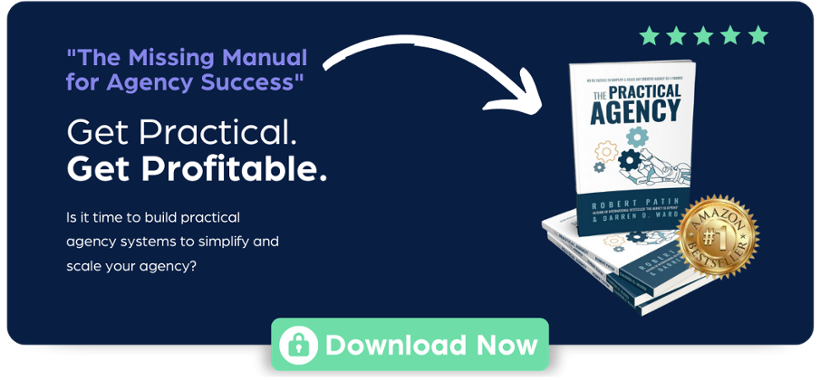Leveraging Analytics for Data-Driven Agency Lead Generation
Lead Generation Analytics For Creative Agencies: The Complete Guide
Are you constantly overwhelmed by the workload your creative agency has taken on, yet you continue to struggle to see any profit growth? This growing pain many agency owners face at some point is a telltale sign that you may be relying too much on instinct rather than concrete data to make decisions for your agency.
Consider this real-life example: a bustling agency, just like yours, once found itself caught in this same cycle. Despite a packed client roster, their profit margins were alarmingly thin. The turning point came when they shifted their focus from gut-driven decisions to a strategy deeply rooted in their data. This pivotal operational change led them from overwhelming workloads to an exceptional milestone: a new annual revenue record of $1.1M with a 21% net profit margin.
Want to know how they did it?
This isn't just an isolated success story -rather it serves as a blueprint for any creative agency looking to harness the full potential of data-driven strategies.
Understanding the Fundamentals: Defining Lead Generation
Sales, in its essence, is a numbers game. It's a straightforward equation: the more effort you invest, the higher the output should be. But what if your efforts aren't yielding the expected returns? What if the balance between effort and reward seems off? That's where data and analytics can offer clarity and direction.
What Lead Data Are We Looking For?

When high effort isn't translating into high returns – it's a clear indicator that the process needs adjusting. This is often where creative agencies hit a snag. They pour resources into attracting as many leads as possible, while failing to see a proportional return on investment. The reason? A lack of understanding of where the process is falling short.
This is where data and analytics shine. They provide a bird's-eye view of your lead generation efforts, allowing you to see which parts of your strategy are working and which aren't.
Analytics can answer critical questions for us such as:
- Where are your leads coming from?
- Which marketing channels are most effective?
- What is the conversion rate at each stage of your funnel?
- How do different client segments respond to your marketing efforts?
- What is your cost of customer acquisition?
By answering these questions, you can identify areas that need improvement, such as a particular stage in the funnel where potential clients are dropping off, or a marketing channel that's not performing as well as others. Not only that, but you can also enhance the accuracy of your financial projections, marking a clear path forward towards success.
Lead Generation Forms and Google Analytics: Tracking for Success
Even the most talented creative agency can’t turn a profit if enough leads aren’t making it into your sales funnel in the first place.
If you want to maximize your lead generation strategy efforts, integrating your lead collection forms with Google Analytics is a game-changer. Here’s how you can set up Google Analytics for your lead generation forms and interpret the data to refine your marketing strategies.
How To Set Up Analytics for Lead Generation Forms:
- Ensure your lead collection forms are integrated properly with Google Analytics. This allows you to track form submissions as goals or events, providing insight into how visitors are interacting with your forms.
- In Google Analytics, set up specific goals related to your lead generation forms. These could include form submissions, newsletter sign-ups, or downloads of your lead magnets. By defining these actions as goals, you can measure the effectiveness of your lead generation efforts with increased precision.
- Utilize the segmentation feature in Google Analytics to analyze the behavior of different users who complete your forms. This segmentation can reveal patterns such as which pages they visited before filling out the form, or what type of content resonates most with your leads.
5 Data Points To Prioritize Informed Decision Making:
For creative agencies looking to boost their bottom line, prioritizing certain data points can make a significant difference.
Here are five crucial data points you need to evaluate the effectiveness of your marketing efforts:
- Conversion Rate Analysis: Closing less than 20% of your leads indicates issues with form design, placement, or the offer itself. Alternatively, a conversion rate of 50% or above indicates it may be time to consider raising your rates.
- User Flow and Drop-off Points: Analyze the user flow in Google Analytics to understand the paths users take before and after interacting with your forms. Identifying drop-off points can highlight areas in your website or funnel that need improvement (for example, changing the call to action, reevaluating your brand promise, etc).
- Referral Source Tracking: Understanding where your leads are coming from is crucial. Google Analytics can show you which marketing channels are driving the most form submissions, helping you allocate your resources more effectively.
- A/B Testing Insights: Use the data from Google Analytics to inform your A/B testing strategy for lead generation forms. Test different versions of your forms in terms of layout, copy, and call-to-action to see which variants are yielding better conversion rates with your audience.
- Behavioral Insights: Knowing how long users stay on the page with your form and how they interact with it can be pivotal in optimizing the user experience to encourage more form submissions.
Harnessing Google Search Console for Keyword Research
For creative agencies, understanding and leveraging the right keywords can be the difference between content that gets lost in the digital shuffle and content that precisely targets and attracts your ideal audience.
Google Search Console can be an invaluable tool, offering a treasure trove of data that can significantly enhance your lead generation strategy. By diving into search query analytics and aligning your content with these insights, you unlock the keywords you need to connect more effectively with your dream client.
Understanding Search Queries:
Google Search Console provides data on the search queries from its database that lead users to your website. This information is crucial for understanding the language your potential clients are using, so you can get in front of them:
- Identify High-Performing Keywords: Analyze the keywords that are currently driving traffic to your site. These are the keywords your audience is actively using and can form the basis of your content optimization strategy.
- Spot The Buzzwords: Look for relevant keywords that have high search volumes but low competition. These are your opportunity areas where you can create content to attract more targeted traffic.
- Analyzing Click-Through Rates (CTRs): Pay attention to the CTR for your keywords. A low CTR on a high-volume keyword indicates a gap. Perhaps your content isn’t aligning well with the search intent, or your meta descriptions need tweaking.
How To Optimize Your Content Strategy Using Keyword Data
Are your content efforts failing to make the impact you hoped for? In the competitive landscape of digital marketing, creating content without considering keyword optimization often leads to missed opportunities to connect with your target audience.
The key to transforming this scenario lies in effectively using keyword insights from Google Search Console. By aligning your content with these insights, you're not just guessing what your audience wants – you're directly addressing their specific search queries and interests.
- Aligning with Search Intent: Ensure your content aligns with the results of the keyword search. If a keyword is transactional (eg. “buy,” “subscribe,” or “for sale”), focus your content on conversions. If it’s informational (eg. “how to,” “why,” or “what is”), provide valuable insights and information.
- Long-Tail Keywords for Niche Targeting: Incorporate long-tail keywords into your content. These longer, more specific phrases can attract a more targeted audience and often have a higher conversion rate.
- Regular Keyword Review and Adaptation: Never forget that the digital landscape and search behaviors are constantly evolving. Regularly review your keyword strategy and adapt your content accordingly to stay relevant and visible to your target audience.
The insights you gain from using the Google Search Console allow you to create content that not only ranks well in search engines but also resonates with the exact audience you’re trying to reach.
Enhancing SEM with Analytics: A Strategic Approach to Lead Generation
Search Engine Marketing (SEM) is a powerful tool creative agencies can use to boost their lead generation efforts. However, to truly yield the best return on your marketing investments, integrating analytics into your SEM strategy is key.
Here’s how you can leverage analytics data to enhance your SEM campaigns and lead to more effective targeting and conversion of leads:
- Data-Driven Targeting: Analytics allow you to understand your audience better - their behaviors, preferences, and the keywords they use. This information is crucial for creating targeted SEM campaigns that resonate with your ideal client profile.
- Performance Analysis: Through analytics, you can track the performance of your SEM campaigns in real time. This includes monitoring click-through rates (CTRs), conversion rates, and return on ad spend (ROAS). By analyzing these metrics, you can identify what’s working and what’s not, allowing for timely adjustments.
- Cost-Effectiveness: Optimize ad spend by understanding which keywords and ad formats are yielding the best results, so you can allocate your budget more effectively, ensuring a better ROI.
- Ad Content Optimization: Analytics provide insights into which ad copy and creatives are performing best, enabling you to refine your ads, ensuring they capture attention and drive action.
- Landing Page Performance: By tracking how users interact with your landing pages after clicking an ad, you can optimize these pages for better conversion. Analytics can even help specify which elements like call-to-action buttons or content sections need improvement.
Know your creative agency needs to start using data to make better decisions, but have no idea where to start?
5 Ways You Can Start Integrating SEM Analytics Into Your Operations Today:
- Regular Monitoring and Adjustment: Continuously monitor your SEM campaign performance and be ready to make adjustments based on the data. This could mean changing your ad copy, adjusting bids, or even pausing underperforming campaigns.
- A/B Testing: Use analytics to conduct A/B tests on different elements of your SEM campaigns. This includes testing various ad copies, landing pages, and keywords to see which combinations yield the best results.
- Audience Segmentation: Utilize analytics to segment your audience based on their behavior and preferences. Tailored ads to these segments can lead to higher engagement and conversion rates.
- Keyword Refinement: Regularly update and refine your keyword list based on analytics data. Add new, relevant keywords and eliminate those that are not performing well.
- Leveraging Analytics Tools: Invest in robust analytics tools that offer in-depth insights into your SEM campaigns. Tools like Google Analytics, SEMrush, or Ahrefs can provide comprehensive data that is critical for decision-making.
Harnessing Data Analytics for Scalable Agency Growth
Remember that creative agency that leveraged analytics to skyrocket their revenue to $1.1M with a 21% net profit margin?
Now you have the same roadmap so you too can transition from making educated guesses to a strategy that's deeply rooted in data and analytics.
This transformation is not just about adopting new tools or technologies; it's about fundamentally changing how you perceive and interact with your business data. By understanding and effectively utilizing analytics, you too can unlock the potential to attract more of your dream clients, leading to profitable, sustainable growth.










